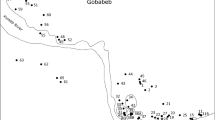Summary
The ant speciesLasius (Lasius) neglectus spec. nov. (van Loon et al., 1990) was sampled from its type locality in Budapest, Hungary for allozyme analysis at four marker loci.L. neglectus appeared to be monomorphic but different fromL. alienus at three loci. The fourth locus,Me, was found to be polymorphic inL. neglectus and was used to make a preliminary assessment of population viscosity, intranest relatedness, and mating structure. Allele frequencies turned out to be homogeneous across motherqueens, males and workers. Between sample sites, theMe allele frequencies of workers were more heterogeneous and some population viscosity could be detected. The mean intranest relatedness ofL. neglectus was found to be very low, both between workers and between workers and males, but no indications were found that queens are frequently inseminated more than once. The analysis of worker genotypes further showed a significant effect of inbreeding. The results are generally consistent with the observations about polygyny and intranidal mating reported byvan Loon et al. (1990). Some striking similarities betweenL. neglectus and the JapaneseL. sakagamii — the only other polygynousLasius s.s. known to science — are discussed.
Resume
Nous avons récolté des échantillons deLasius (Lasius) neglectus spec. nov. dans la localité type à Budapest, Hongrie, pour effectuer une analyse des allozymes. Nous avons étudié quatre loci. Trois loci deL. neglectus sont monomorphes et différents deL. alienus. L'autre locus, l'enzyme malique (Me), est polymorphe chezL. neglectus. Ce locus a été utilisé afin d'étudier la viscosité de population, le coefficient de parenté entre ouvrières du même nid et les modalités d'accouplement. Les fréquences d'allèles sont homogènes entre les reines, les mâles et les ouvrières. Les fréquences de génotypes chez les ouvrières sont plus hétérogènes entre les nids et on peut détecter une certaine viscosité de la population. Dans les nids deL. neglectus, le coefficient de parenté entre ouvrières et entre ouvrières et mâles est très faible. Les reines semblent n'être inséminées que par un seul mâle. L'analyse de génotypes des ouvrières indique aussi l'existence d'une certaine consanguinité. En général, les résultats correspondent avec les observations sur le terrain (polygynie et accouplement dans le nid) (voirvan Loon et al., 1990). Nous comparons dans la discussion la structure sociale deL. neglectus avec celle de l'unique autre espèce deLasius s.s. polygyne connue (L. sakagamii).
Similar content being viewed by others
References
Agosti D., Collingwood C.A., 1987. — A provisional list of the Balkan ants (Hym. Formicidae) with a key to the worker caste. II. Key to the worker caste, including the European species without the Iberian.Mitt. Schw. Ent. Ges., 60, 261–293.
Collingwood C.A., 1979. — The Formicidae (Hymenoptera) of Fennoscandia and Denmark.Fauna Ent. Scand., 8, Klampenborg, Denmark, 174 pp.
Crozier R.H., Pamilo P., Crozier Y.C., 1984. — Relatedness and microgeographic genetic variation inRhytidoponera mayri, an Australian arid-zone ant.Behav. Ecol. Sociobiol., 15, 143–150.
Hamilton W.D., 1964. — The genetical evolution of social behaviour.I. J. Theoret. Biol., 7, 1–16.
Van der Have T.M., Boomsma J.J., Menken S.B.J., 1988. — Sex-investment ratios and relatedness in the monogynous antLasius niger (L.).Evolution 42, 160–172.
Van Loon A.J., Boomsma J.J., Andrasfalvy A., 1990. — A new polygynousLasius species (Hymenoptera: Formicidae) from central Europe. I. Description and general biology.Insectes soc., 37, 348–362.
Menken S.B.J., 1982. — Biochemical genetics and systematics of small ermine moths (Lepidoptera, Yponomeutidae).Z. Zool. Syst. Evolut.-forsch., 20, 131–143.
Pamilo P., 1982a. — Genetic population structure in polygynousFormica ants.Heredity, 48, 95–106.
Pamilo P., 1982b. — Multiple mating inFormica ants.Hereditas, 97, 37–45.
Pamilo P., 1985. — Effect of inbreeding on genetic relatedness.Hereditas, 103, 195–200.
Pamilo P., Crozier R.H., 1982. — Measuring genetic relatedness in natural populations: Methodology.Theoret. Popul. Biol., 21, 171–193.
Pamilo P., Rosengren R., 1983. — Sex ratio strategies inFormica ants.Oikos, 40, 24–35.
Pamilo P., Rosengren R., 1984. — Evolution of nesting strategies of ants: genetic evidence from different population types ofFormica ants.Biol. J. Linn. Soc., 21, 331–348.
Ross K.G., Fletcher D.J.C., 1985. — Comparative study of genetic and social structure in two forms of the fire antSolenopsis invicta (Hymenoptera: Formicidae).Behav. Ecol. Sociobiol., 17, 349–356.
Traniello J.F.A., Levings S.C., 1986. — Intra- and intercolony patterns of nest dispersion in the antLasius neoniger: correlations with territoriality and foraging ecology.Oecologia (Berl.), 69, 413–419.
Wilson E.O., 1955. — A monographic revision of the ant genusLasius.Bull. Mus. Comp. Zool., Harvard Coll., 113, 1–199.
Yamauchi K., Hayashida K., 1970. — Taxonomic studies on the genusLasius in Hokkaido, with ethological and ecological notes (Formicidae, Hymenoptera). II. The subgenusLasius.J. Fac. Sci., Hokkaido Univ., Ser. VI, Zool., 17, 510–519.
Yamauchi K., Kinomura K., Miyake S., 1981. — Sociobiological studies of the polygynic antLasius sakagamii. I. General features of its polydomous system.Insectes soc., 28, 279–296.
Yamauchi K., Kinomura K., Miyake S., 1982. — Sociobiological studies of the polygynic antLasius sakagamii. II. Production of colony members.Insectes soc., 29, 164–174.
Author information
Authors and Affiliations
Rights and permissions
About this article
Cite this article
Boomsma, J.J., Brouwer, A.H. & Van Loon, A.J. A new polygynousLasius species (Hymenoptera: Formicidae) from central Europe. Ins. Soc 37, 363–375 (1990). https://doi.org/10.1007/BF02225998
Received:
Accepted:
Issue Date:
DOI: https://doi.org/10.1007/BF02225998



